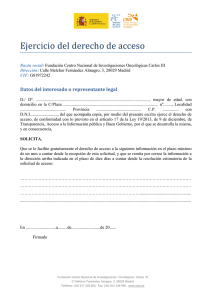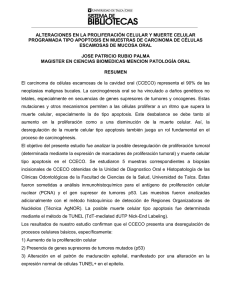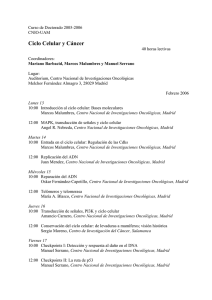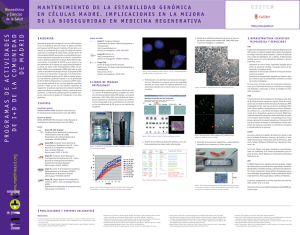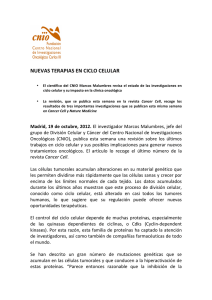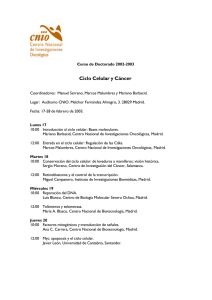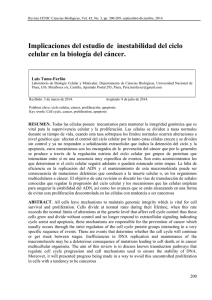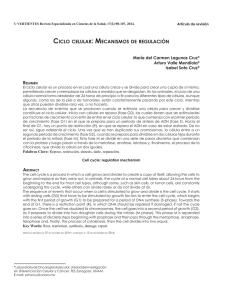Programa (pdf 22 KB)
Anuncio
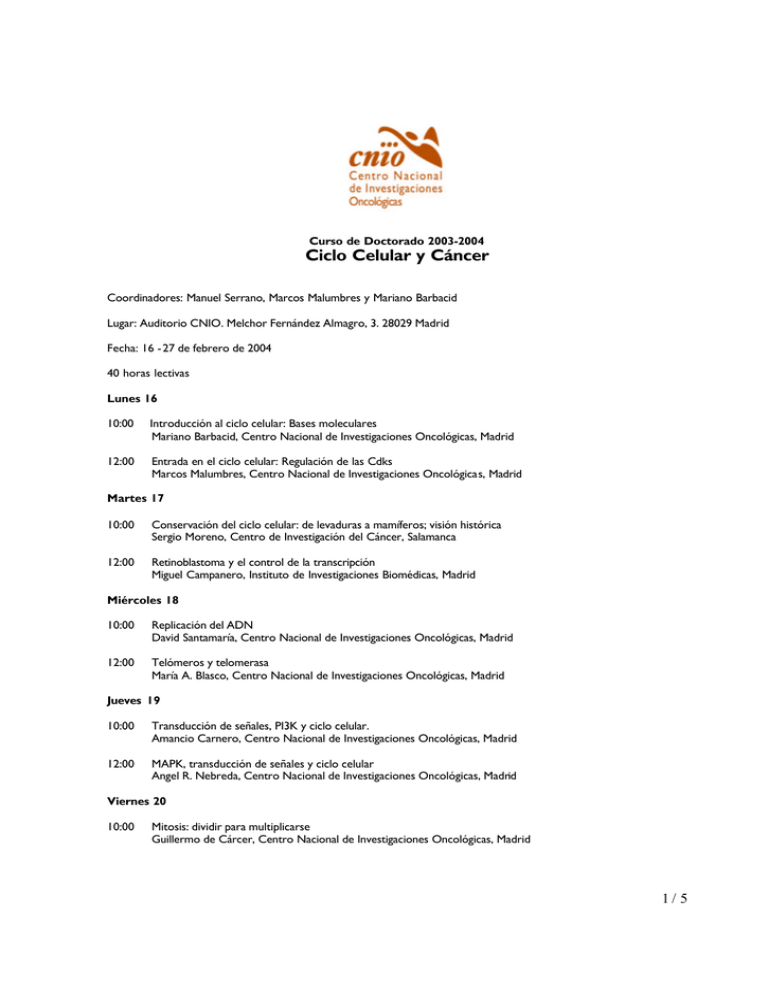
Curso de Doctorado 2003-2004 Ciclo Celular y Cáncer Coordinadores: Manuel Serrano, Marcos Malumbres y Mariano Barbacid Lugar: Auditorio CNIO. Melchor Fernández Almagro, 3. 28029 Madrid Fecha: 16 - 27 de febrero de 2004 40 horas lectivas Lunes 16 10:00 Introducción al ciclo celular: Bases moleculares Mariano Barbacid, Centro Nacional de Investigaciones Oncológicas, Madrid 12:00 Entrada en el ciclo celular: Regulación de las Cdks Marcos Malumbres, Centro Nacional de Investigaciones Oncológicas, Madrid Martes 17 10:00 Conservación del ciclo celular: de levaduras a mamíferos; visión histórica Sergio Moreno, Centro de Investigación del Cáncer, Salamanca 12:00 Retinoblastoma y el control de la transcripción Miguel Campanero, Instituto de Investigaciones Biomédicas, Madrid Miércoles 18 10:00 Replicación del ADN David Santamaría, Centro Nacional de Investigaciones Oncológicas, Madrid 12:00 Telómeros y telomerasa María A. Blasco, Centro Nacional de Investigaciones Oncológicas, Madrid Jueves 19 10:00 Transducción de señales, PI3K y ciclo celular. Amancio Carnero, Centro Nacional de Investigaciones Oncológicas, Madrid 12:00 MAPK, transducción de señales y ciclo celular Angel R. Nebreda, Centro Nacional de Investigaciones Oncológicas, Madrid Viernes 20 10:00 Mitosis: dividir para multiplicarse Guillermo de Cárcer, Centro Nacional de Investigaciones Oncológicas, Madrid 1/ 5 12:00 Securina/PTTG1: ciclo celular y tumorigénesis José A. Pintor-Toro, 1Instituto de Recursos Naturales y Agrobiología, Sevilla, Lunes 23 10:00 Checkpoints I: Detección y respuesta al daño en el DNA Manuel Serrano, Centro Nacional de Investigaciones Oncológicas, Madrid 12:00 Checkpoints II: La ruta de p53 Manuel Serrano, Centro Nacional de Investigaciones Oncológicas, Madrid Martes 24 10:00 Análisis genético del ciclo celular: modelos animales Mariano Barbacid, Centro Nacional de Investigaciones Oncológicas, Madrid 12:00 Myc: proliferación, apoptosis y el ciclo celular Ignacio Moreno de Alborán, Centro Nacional de Biotecnología, Madrid Miércoles 25 10:00 Alteraciones del ciclo celular en tumores humanos Miguel Ángel Piris, Centro Nacional de Investigaciones Oncológicas, Madrid 12:00 Implicaciones del ciclo celular en pronóstico del cáncer Félix Bonilla, Clínica Puerta del Hierro, Madrid Jueves 26 10:00 Journal Club: Bases Moleculares del ciclo celular I Presentaciones de los alumnos 12:00 Journal Club: Bases Moleculares del ciclo celular I Presentaciones de los alumnos Viernes 27 10:00 Journal Club: Ch eckpoints Presentaciones de los alumnos 12:00 Journal Club: Ciclo celular y cáncer humano Presentaciones de los alumnos 2/ 5 Referencias Retinoblastoma y el control de la transcripción / M. Campanero Dick FA, Dyson N. pRB contains an E2F1 -specific binding domain that allows E2F1-induced apoptosis to be regulated separately from other E2F activities. Mol Cell. 2003 Sep; 12(3): 639-49. Li FX, Zhu JW, Tessem JS, Beilke J, Varella-Garcia M, Jensen J, Hogan CJ, DeGregori J. The development of diabetes in E2f1/E2f2 mutant mice reveals important roles for bone marrow-derived cells in preventing islet cell loss. Proc Natl Acad Sci U S A. 2003 Oct 28; 100(22): 12935-40. Di Stefano L, Jensen MR, Helin K. E2F7, a novel E2F featuring DP-independent repression of a subset of E2F-regulated genes. EMBO J. 2003 Dec 1; 22(23): 6289-98. Wikonkal NM, Remenyik E, Knezevic D, Zhang W, Liu M, Zhao H, Berton TR, Johnson DG, Brash DE. Inactivating E2f1 reverts apoptosis resistance and cancer sensitivity in Trp53-deficient mice. Nat Cell Biol. 2003 Jul; 5(7): 655-60. Hallstrom TC, Nevins JR. Specificity in the activation and control of transcription factor E2F-dependent apoptosis. Proc Natl Acad Sci U S A. 2003 Sep 16; 100(19): 10848-53. Checkpoints / M. Serrano Villunger A, Michalak EM, Coultas L, Mullauer F, Bock G, Ausserlechner MJ, Adams JM, Strasser A. p53- and druginduced apoptotic responses mediated by BH3-only proteins puma and noxa. Science. 2003 Nov 7; 302(5647): 1036-8. Vassilev LT, Vu BT, Graves B, Carvajal D, Podlaski F, Filipovic Z, Kong N, Kammlott U, Lukacs C, Klein C, Fotouhi N, Liu EA. In Vivo Activation of the p53 Pathway by Small-Molecule Antagonists of MDM2. Science. 2004 Garcia-Cao I, Garcia-Cao M, Martin-Caballero J, Criado LM, Klatt P, Flores JM, Weill JC, Blasco MA, Serrano M. "Super p53" mice exhibit enhanced DNA damage response, are tumor resistant and age normally. EMBO J. 2002 Nov 15; 21(22): 6225-35. Telómeros y telomerasa / María A. Blasco Garcia-Cao M, O'Sullivan R, Peters AH, Jenuwein T, Blasco MA. Epigenetic regulation of telomere length in mammalian cells by the Suv39h1 and Suv39h2 histone methyltransferases.Nat Genet. 2004 Jan; 36(1): 94-9. Epub 2003 Dec 14. Seger YR, Garcia-Cao M, Piccinin S, Cunsolo CL, Doglioni C, Blasco MA, Hannon GJ, Maestro R. Transformation of normal human cells in the absence of telomerase activation. Cancer Cell. 2002 Nov; 2(5): 401-13. Masutomi K, Yu EY, Khurts S, Ben-Porath I, Currier JL, Metz GB, Brooks MW, Kaneko S, Murakami S, DeCaprio JA, Weinberg RA, Stewart SA, Hahn WC. Telomerase maintains telomere structure in normal human cells. Cell. 2003 Jul 25; 114(2): 241-53. Securina/PTTG1: ciclo celular y tumorigénesis / JA Pintor-Toro Ramaswamy, S. et al "A molecular signature of metastasis in primary solid tumors". Nat Genet 23: 49-54 (2003). 3/ 5 Bernal, J.A et al "Human securin interacts with p53 and modulates p53-mediated transcriptional activity and apoptosis". Nat Genet 32: 306-311 (2002). Uhlmann, F. "Chromosome cohesion and separation: from men and molecules". Current Biology 13: R104-R114 (2003). Pollard, J.W. "Tumour-educated macrophages promote tumour progression and metastasis". Nature Rev Cancer 4: 7178 (2004). Myc: proliferación, apoptosis y el ciclo celular / I. Moreno de Alborán Eischen CM, Weber JD, Roussel MF, Sherr CJ and Cleveland JL (1999) Disruption of the ARF-Mdm2-p53 tumor suppressor pathway in Myc-induced lymphomagenesis. Genes Dev 13 (20): 2658-69. Trumpp A, Refaeli Y, Oskarsson T, Gasser S, Murphy M, Martin GR and Bishop JM (2001) c-Myc regulates mammalian body size by controlling cell number but not cell size. Nature 414 (6865): 768-73. Nair SK and Burley SK (2003) X-ray structures of Myc-Max and Mad-Max recognizing DNA. Molecular bases of regulation by proto-oncogenic transcription factors. Cell 112 (2): 193-205. Gomez-Roman N, Grandori C, Eisenman RN and White RJ (2003) Direct activation of RNA polymerase III transcription by c-Myc. Nature 421 (6920): 290 -4. Johnston LA, Prober DA, Edgar BA, Eisenman RN and Gallant P (1999) Drosophila myc regulates cellular growth during development. Cell 98 (6): 779-90. Malynn B. A., Moreno de Alboran I., O’Hagan R.C., Bronson R., Davidson L., DePinho R.A. and F.W. aA (2000) N-myc can functionally replace c-myc in murine development , cellular growth, and differentation. Genes Dev 14: 1390-1399. Juin P, Hueber AO, Littlewood T and Evan G (1999) c-Myc-induced sensitization to apoptosis is mediated through cytochrome c release. Genes Dev 13 (11): 1367-81. Knoepfler PS, Cheng PF and Eisenman RN (2002) N-myc is essential during neurogenesis for the rapid expansion of progenitor cell populations and the inhibition of neuronal differentiation. Genes Dev 16 (20): 2699-712. Alteraciones del ciclo celular en tumores humanos / M.A. Piris Martinez N, Camacho FI, Algara P, Rodriguez A, Dopazo A, Ruiz-Ballesteros E, Martin P, Martinez-Climent JA, GarciaConde J, Menarguez J, Solano F, Mollejo M, Piris MA. The molecular signature of mantle cell lymphoma reveals multiple signals favoring cell survival. Cancer Res. 2003 Dec 1; 63(23): 8226-32. Sanchez-Aguilera A, Delgado J, Camacho FI, Sanchez-Beato M, Sanchez L, Montalban C, Fresno MF, Martin C, Piris MA, Garcia JF. Silencing of the p18INK4c gene by promoter hypermethylation in the Reed Sternberg cells in Hodgkin Lymphomas. Blood. 2003 Nov 26 Garcia JF, Camacho FI, Morente M, Fraga M, Montalban C, Alvaro T, Bellas C, Castano A, Diez A, Flores T, Martin C, Martinez MA, Mazorra F, Menarguez J, Mestre MJ, Mollejo M, Saez AI, Sanchez L, Piris MA; Spanish Hodgkin Lymphoma Study Group. Hodgkin and Reed-Sternberg cells harbor alterations in the major tumor suppressor pathways and cell-cycle checkpoints: analyses using tissue microarrays. Blood. 2003 Jan 15; 101(2): 681-9. Epub 2002 Sep 12. Sanchez-Beato M, Sanchez-Aguilera A, Piris MA. Cell cycle deregulation in B-cell lymphomas. Blood. 2003 Feb 15; 101(4): 1220-35. Epub 2002 Sep 12. 4/ 5 Sanchez-Aguilera A, Sanchez-Beato M, Garcia JF, Prieto I, Pollan M, Piris MA. p14(ARF) nuclear overexpression in aggressive B-cell lymphomas is a sensor of malfunction of the common tumor suppressor pathways. Blood. 2002 Feb 15; 99(4): 1411-8. Implicaciones del ciclo celular en pronóstico del cáncer / F. Bonilla K Keyomarsi, et al. Cyclin E and survival in patients with breast cancer. New Engl J Med. 347: 1566-1575; 2002. Van de Vijver MJ, et al. A gene-expression signature as a predictor of survival in breast cancer. New Engld J Med. 347: 1999-2009; 2002. A Ahrendt, et al. p53 mutations and survival in stage I non-small-cell lung cancer: Results of a prospective study. J Natl Cancer Inst. 95: 961-970; 2003. SB Bull, et al. The combination of p53 mutation and neu/erbB-2 amplification is associated with poor survival in nodenegative breast cancer. J Clin Oncol. 22: 86-96; 2004. G Pohl, et al. High p27Kip1 expression predicts superior relapse-free and overall survival for premenopausal women with early-stage breast cancer receiving adjuvant treatment with tamoxifen plus goserelin. J Clin Oncol. 21: 3594-3600; 2003. 5/ 5
